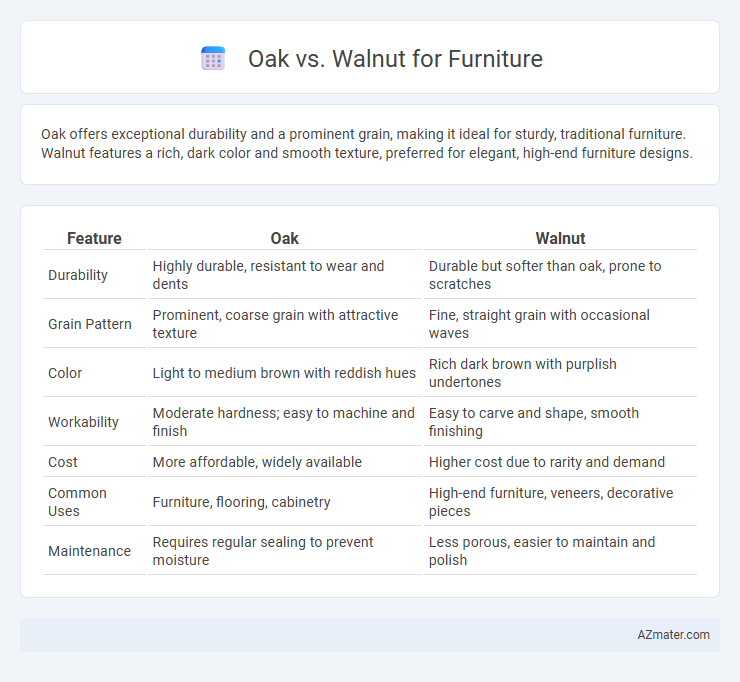Oak offers exceptional durability and a prominent grain, making it ideal for sturdy, traditional furniture. Walnut features a rich, dark color and smooth texture, preferred for elegant, high-end furniture designs.
Table of Comparison
| Feature | Oak | Walnut |
|---|---|---|
| Durability | Highly durable, resistant to wear and dents | Durable but softer than oak, prone to scratches |
| Grain Pattern | Prominent, coarse grain with attractive texture | Fine, straight grain with occasional waves |
| Color | Light to medium brown with reddish hues | Rich dark brown with purplish undertones |
| Workability | Moderate hardness; easy to machine and finish | Easy to carve and shape, smooth finishing |
| Cost | More affordable, widely available | Higher cost due to rarity and demand |
| Common Uses | Furniture, flooring, cabinetry | High-end furniture, veneers, decorative pieces |
| Maintenance | Requires regular sealing to prevent moisture | Less porous, easier to maintain and polish |
Introduction: Oak vs Walnut Furniture
Oak and walnut are premium hardwoods widely favored in furniture making for their durability and distinct aesthetic qualities. Oak features a prominent grain pattern and a light to medium brown tone, offering a classic, rustic appeal, while walnut is prized for its rich, dark brown color and smooth texture, delivering a sophisticated, elegant look. Both woods provide excellent strength, making them ideal for high-quality, long-lasting furniture pieces suited to various interior styles.
Wood Characteristics: Oak and Walnut
Oak features a prominent grain with high hardness and excellent durability, making it resistant to wear and ideal for heavy-use furniture. Walnut exhibits a smoother, more refined grain pattern with rich dark brown tones and moderate hardness, favored for its elegant appearance and ease of carving. Both woods offer stability and longevity, but oak's coarse texture contrasts with walnut's fine, uniform grain.
Appearance and Grain Patterns
Oak furniture showcases a prominent grain pattern with a coarse texture, featuring distinct rays and flecks that create a visually striking appearance. Walnut, on the other hand, offers a smoother, more refined grain with rich, darker tones ranging from deep chocolate to purplish hues, often displaying straight grains or attractive swirls. These characteristics make oak ideal for rustic or traditional styles, while walnut suits elegant, modern designs with its luxurious finish.
Strength and Durability Comparison
Oak offers exceptional strength and durability, making it a top choice for heavy-use furniture due to its dense grain and resistance to wear. Walnut, while slightly softer, provides robust durability with a smooth, tight grain that resists warping and cracking over time. Both hardwoods deliver long-lasting furniture quality, but oak's higher Janka hardness rating (around 1360) surpasses walnut's (around 1010), ensuring greater impact resistance and longevity.
Workability and Craftsmanship
Oak offers excellent workability due to its coarse grain and hardness, making it ideal for furniture requiring durability and intricate detailing. Walnut features a fine, straight grain that enhances smoothness and ease of carving, favored for high-end craftsmanship and elegant finishes. Both woods provide unique advantages, with oak excelling in robustness and walnut in refined aesthetics for skilled artisans.
Cost Differences: Oak vs Walnut
Oak furniture typically costs less than walnut due to its faster growth rate and greater availability, making it a budget-friendly choice for homeowners. Walnut is valued for its rich, dark color and fine grain, resulting in higher prices linked to limited supply and slower growth. Choosing between oak and walnut hinges on balancing cost considerations with desired aesthetics and durability in furniture design.
Maintenance and Longevity
Oak furniture is highly durable and resistant to wear, requiring minimal maintenance such as occasional dusting and polishing to preserve its natural grain. Walnut, while also strong and long-lasting, demands more careful upkeep including regular conditioning to prevent drying and surface cracking over time. Both woods offer exceptional longevity, but oak's denser grain structure typically provides greater resilience against dents and scratches in high-traffic environments.
Best Uses for Oak Furniture
Oak excels in furniture manufacturing due to its durability, attractive grain patterns, and resistance to wear, making it ideal for high-traffic items like dining tables, chairs, and cabinets. Its dense structure and natural hardness ensure long-lasting strength, while the light to medium brown tones with subtle grain swirls enhance rustic and traditional interior designs. Oak furniture works best in environments requiring sturdy construction combined with aesthetic appeal, particularly for pieces subjected to frequent use and heavy loads.
Best Uses for Walnut Furniture
Walnut furniture is prized for its rich, dark brown color and smooth grain, making it ideal for high-end pieces such as dining tables, desks, and cabinetry where a luxurious aesthetic is desired. Its natural durability and resistance to wear make walnut suitable for heirloom-quality furniture that maintains beauty over time. Walnut's fine texture and workability also allow for intricate carvings and detailed designs, enhancing the sophistication of furniture in living rooms and offices.
Choosing the Right Wood for Your Furniture
Oak offers exceptional durability and a prominent grain pattern ideal for high-traffic furniture, while walnut features a rich, dark color and smooth texture that suits elegant, statement pieces. Oak's hardness ranges from 1290 to 1360 on the Janka scale, making it resistant to dents and scratches, whereas walnut scores around 1010, balancing strength with workability. Selecting between oak and walnut depends on desired aesthetics, durability needs, and budget, with oak generally being more cost-effective and walnut more luxurious.

Infographic: Oak vs Walnut for Furniture
 azmater.com
azmater.com